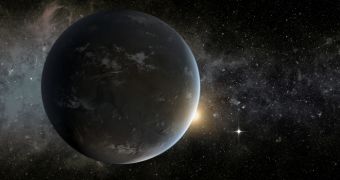When the latest batch of exoplanetary detections were announced in late 2013, the dataset also included a world called Kepler-62f, which is very much like Earth in many ways. The conclusions of recent studies appear to indicate that this world, alongside its neighbor Kepler-62e, may be covered in water.
Astronomers were also able to determine that the planet lies in its parent star's habitable zone, which is an area where temperatures are just right to support the presence of liquid water. Similarly, Earth lies right in the middle of the Sun's habitable zone.
This combination of a right distance from the star and the presence of liquid water on its surface makes Kepler-62f an ideal candidate for the development of life. However, experts say, if life does exist on this world, then it most likely looks a lot different than what we are used to seeing.
The exoplanet orbits the star Kepler-62, which is significantly smaller and dimmer than the Sun. The cosmic object lies around 1,200 light-years away from our planet, and is roughly 1.4 times larger than Earth. Its neighbor, Kepler-62e, is about 1.6 times the size of our planet, Space reports.
“There may be life there, but could it be technology-based like ours? Life on these worlds would be under water with no easy access to metals, to electricity, or fire for metallurgy,” said in a statement Lisa Kaltenegger, who led the efforts to model the surfaces of the two worlds based on telescope data.
The expert holds joint appointments with the Max Planck Institute for Astronomy, in Germany, and the Harvard-Smithsonian Center for Astrophysics (CfA), in the United States. “Nonetheless, these worlds will still be beautiful blue planets circling an orange star – and maybe life’s inventiveness to get to a technology stage will surprise us,” she said.
According to data from the NASA planet-hunting Kepler Space Telescope, the exoplanet Kepler-62f orbits its parent star once every 267 days, as opposed to Earth's 365-day orbit. This puts in about as far away from the dim star as Venus is from the Sun. Though closer, the exoplanet is not necessarily warmer, due to the reduced size of its star.
“Look at our own ocean – it is just absolutely full of life. We think, in fact, life might have begun there,” commented NASA Ames Research Center expert Bill Borucki, who led the team that discovered the two alien worlds last year.

 14 DAY TRIAL //
14 DAY TRIAL //